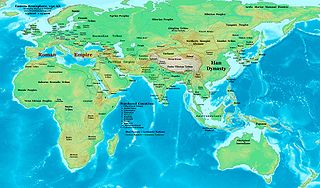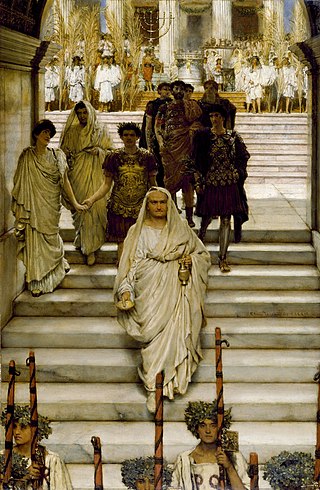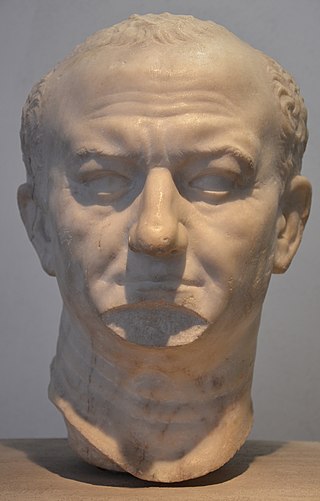
Vespasian was Roman emperor from 69 to 79. The fourth and last emperor who reigned in the Year of the Four Emperors, he founded the Flavian dynasty that ruled the Empire for 27 years. His fiscal reforms and consolidation of the empire generated political stability and a vast Roman building program.

AD 79 (LXXIX) was a common year starting on Friday of the Julian calendar. At the time, it was known as the Year of the Consulship of Titus and Vespasianus. The denomination AD 79 for this year has been used since the early medieval period, when the Anno Domini calendar era became the prevalent method in Europe for naming years.

The 50s decade ran from January 1, 50, to December 31, 59. It was the sixth decade in the Anno Domini/Common Era, if the nine-year period from 1 AD to 9 AD is considered as a "decade".

The 70s was a decade that ran from January 1, AD 70, to December 31, AD 79.

The 80s was a decade that ran from January 1, AD 80, to December 31, AD 89.
AD 51 (LI) was a common year starting on Friday of the Julian calendar. At the time, it was known as the Year of the Consulship of Caesar and Scipio. The denomination AD 51 for this year has been used since the early medieval period, when the Anno Domini calendar era became the prevalent method in Europe for naming years.
AD 76 (LXXVI) was a leap year starting on Monday of the Julian calendar. At the time, it was known as the Year of the Consulship of Titus and Vespasianus. The denomination AD 76 for this year has been used since the early medieval period, when the Anno Domini calendar era became the prevalent method in Europe for naming years.

Titus Caesar Vespasianus was Roman emperor from 79 to 81. A member of the Flavian dynasty, Titus succeeded his father Vespasian upon his death.

Legio XXII Deiotariana was a legion of the Imperial Roman army, founded ca. 48 BC and disbanded or destroyed during the Bar Kokhba revolt of 132–136. Its cognomen comes from Deiotarus, a Celtic king of Galatia. Its emblem is unknown.

Legio XIII Gemina, in English the 13th Twin Legion was a legion of the Imperial Roman army. It was one of Julius Caesar's key units in Gaul and in the civil war, and was the legion with which he crossed the Rubicon in January, perhaps the 10th, 49 BC. The legion appears to have still been in existence in the 5th century AD. Its symbol was the lion.
Titus Flavius may refer to
Titus Flavius Vespasianus may refer to two Roman emperors:

The Flavian dynasty ruled the Roman Empire between AD 69 and 96, encompassing the reigns of Vespasian (69–79), and his two sons Titus (79–81) and Domitian (81–96). The Flavians rose to power during the civil war of 69, known as the Year of the Four Emperors. After Galba and Otho died in quick succession, Vitellius became emperor in mid 69. His claim to the throne was quickly challenged by legions stationed in the Eastern provinces, who declared their commander Vespasian emperor in his place. The Second Battle of Bedriacum tilted the balance decisively in favour of the Flavian forces, who entered Rome on 20 December. The following day, the Roman Senate officially declared Vespasian emperor of the Roman Empire, thus commencing the Flavian dynasty. Although the dynasty proved to be short-lived, several significant historic, economic and military events took place during their reign.

Lucius is a male given name derived from Lucius, one of the small group of common Latin forenames (praenomina) found in the culture of ancient Rome. Lucius derives from Latin word Lux, meaning "light", and is a cognate of the name Lucas. Another etymology proposed is a derivation from Etruscan Lauchum meaning "king", which however was transferred into Latin as Lucumo. Lucy is the feminine derivative of the name.

The gens Flavia was a plebeian family at ancient Rome. Its members are first mentioned during the last three centuries of the Republic. The first of the Flavii to achieve prominence was Marcus Flavius, tribune of the plebs in 327 and 323 BC; however, no Flavius attained the consulship until Gaius Flavius Fimbria in 104 BC. The gens became illustrious during the first century AD, when the family of the Flavii Sabini claimed the imperial dignity.

The Stele of Vespasian is a stele with Ancient Greek inscriptions found in 1867 at Armazi, near Mtskheta, Georgia in the ancient capital of the Caucasian Kingdom of Iberia. The stele memorialises reinforcement of fortification of Armazi walls by Emperor Vespasian. Additionally, the inscription mentions two emperors Titus, Domitian and two kings Mihrdat I of Iberia, Pharasmanes I of Iberia and prince royal Amazaspus. The inscription is dated 75 AD. The top of the stele is lost. According to Professor David Braund the missing text was in Latin or Armazic. Cyril Toumanoff identifies Amazaspus as King Amazasp I of Iberia, though it can be prince royal Amazaspus, son of Pharasmanes I of Iberia, who is known from the Epigram of Amazaspos found in Rome.

Lucius Vorenus and Titus Pullo were two Roman centurions mentioned in the personal writings of Julius Caesar. Although it is sometimes stated they were members of the 11th Legion, Caesar never states the number of the legion concerned, giving only the words in ea legione. All that is known is that the legion in which they served under Caesar was one commanded at the time by Quintus Cicero.
This page is based on this
Wikipedia article Text is available under the
CC BY-SA 4.0 license; additional terms may apply.
Images, videos and audio are available under their respective licenses.











